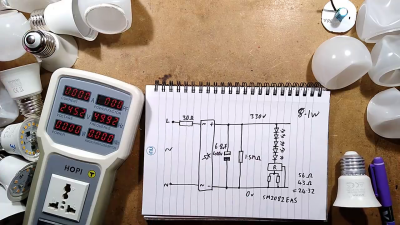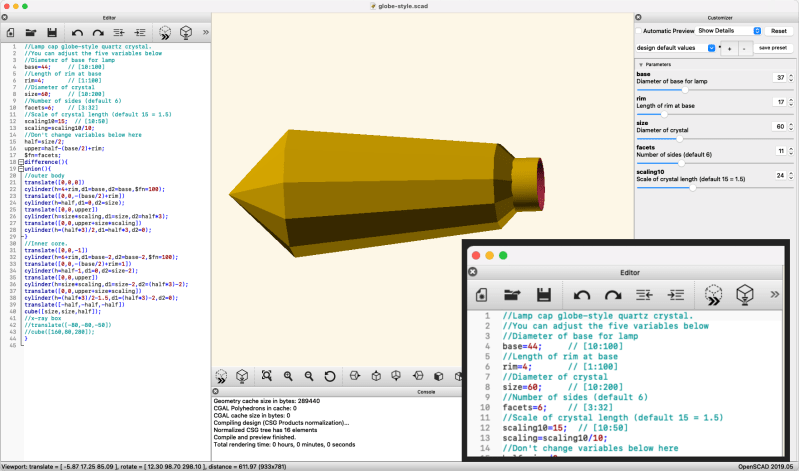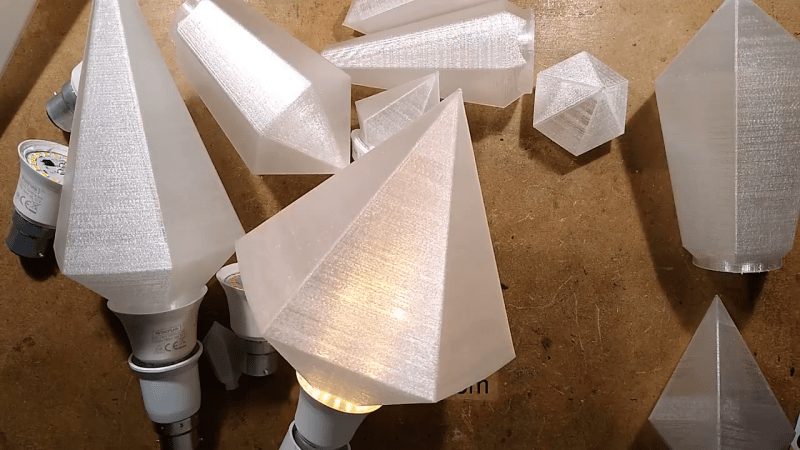After accidentally crushing the plastic envelope on a cheap LED light bulb, [bigclivedotcom] figured out he could make custom ones using OpenSCAD in any shape he wants. He previously hacked a bunch of these inexpensive LED bulbs last month, discovering they all shared a similar circuit topology. All the ones he experimented with drove the LEDs hard, something that’s bound to reduce bulb lifetime. By reverse engineering the current control regulator, it turns out it is easy to adjust the drive current by changing a resistor or two. Reducing the current should not only increase lifetime, but could allow repurposing the bulb for other uses, such as decorative lighting.

Three OpenSCAD scripts are provided which generate what he calls diamond, obelisk, and globe styles. Basic parameters for each style can be tweaked by the user, such as feature sizes and number of facets. He mentions the lack of OpenSCAD customizers in his script — this can easily be added as shown in the following example (this section of the User Manual on customizers explains the syntax). Note that you can’t make the slider generate real numbers, only whole numbers, which is why the scaling factor is multiplied by 10.

These fancy globes can be used as night lights and possibly outdoor lighting, if you can make a good seal with the base. Custom chandeliers, anyone? Indicator lamps for very large panels? Any other ideas? If you want to explore the LED lifetime issue further, inveterate tinkerer Ted Yapo wrote a deep dive into the mythical 100,000 hour LED bulb. Thanks to [Cliff Claven] for the tip.















nice hack. I discovered as a side effect that “opaque” PLA/ABS is actually not so opaque when used as a lamp shade, so this can be sed for interesting effects, too.
It’s the logical next step and I’m honestly surprised someone else hadn’t done it already. I’ve made shades and shrouds before, but never considered a complete re-cap. Props to Big Clive, he is one of my favorites on the tube.
A note for outdoor use… These look like vase mode or normal with 0% infill + a very thin wall. It’s almost certainly not going to be waterproof unless you print it very slow or you have a very consistent printer. Oh and don’t forget PLA absorbs water and is easily heated to the point of sagging under it’s own weight in sunlight. Best to use ABS or some other higher temp filament if you intend to use it outdoors.
With a little thought to avoiding supports and the part needing to be hollow, any shape could be used to re-cap led bulbs.
“and I’m honestly surprised someone else hadn’t done it already”
Why do you think it hasn’t been done already. The fact that you don’t have seen/heard about it earlier doesn’t automatically mean it has never happened?. Big clive has a channel/audience and therefore can reach people and “claim the fame” (please don’t take “claiming to literal” it is a figure of speech). While some shy little old lady (or cool grandpa) with a 3D printer might be doing this for years for the grand kids but simply isn’t noticed, this doesn’t mean it didn’t happen.
Our vision of the world is shaped by the shallow, biased and limited information we get and there is a lot of info that never reaches us. But since we are not aware of the things that don’t reach us, we are tempted to assume we know it all. And this makes us blind for the obvious but keeps us amazed when it is shown leaving us with the rhetorical question “why this hasn’t been presented to us earlier?”
Nonetheless… it’s a cool project and the tip of changing the power output of the lamp is information that can benefit us all, so first time or not, who cares? It’s the fun that matters.
Get out the wrong side of bed? Did that really need to be said Jan? Take a chill pill man.
Big Clive gets a better quality of cheap crap than I do. All of the bulbs I’ve bought here use a capacitive dropper, and no current regulator at all. Along with that, the wires connecting the PCB to the socket are only pressed rather than being welded or soldered to the contacts – they all start flickering. Even the more expensive ones are built like that. Utter crap.
Slightly unrelated:
I opened up one of the failed Sylania LED bulb for my kitchen with a knive to cut around the grove. The MOSFET inside was shorted completely. There are no fuses inside and the LEDs seems to be blown open. Yikes!
The funny thing is that the clear LED bulb for my bathroom (bought from aliexpress) is still working after may be 2-3X as long ATM and it gets much more on/off cycles per day. It uses a film cap for drop and more LEDs on multiple PCB. Likely it is more conservative design. It is pretty sad that aliexpress one is better than the local store bought garbage.
I crushed the plastic bulb and discovered it is a secret bright grow light for cheap
I love Big Clive, he’s like Hagrid the Hacker! So I guess you could 3D print cartoon characters in coloured material for the kiddies?
You know, the more I think about it, the more I’m not sure it’s all that wise. Not to say that Big Clive doesn’t know what he’s doing, I’m sure he’s taken all the variables into account. But I have some led bulbs that get quite hot, and other that only get a little warm. I don’t think I would trust most to consider how hot the bulb will get with continuous use. I’m imagining PLA deforming and dropping onto the led circuit board, I honestly don’t know if those birds would get hot enough to ignite PLA if it was smothered in it. I really think picking the right bulb is going to be important for safety.
Big Clive has always been quite enthusiastic about running LEDs at low currents to not bake them, so I’m sure he’ll be doing that with his homemade bulbs. I guess people who follow him will be doing things similarly, but you’re right it’s possible.
jack324 have you watched his channel? Amongst other industrial electronics jobs he does and has done he installs / maintains lighting for massive music venues. He knows his sausages! He has some nice back of stage stuff from the Edinburgh tattoo a few years ago.